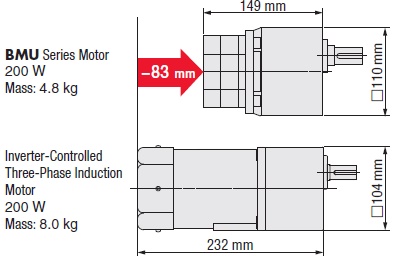What motors do you use for pumps? For variable speed pump applications that typically use 3-phase AC induction motors with variable frequency drives (VFDs), there is another type of motor that can transfer fluids more consistently and help reduce footprint.
Let's take a look at 2 typical motor challenges in pump applications.

For many pump applications, such as fluid control, one would imagine that speed consistency is pretty important. You want to be able to control the rate of fluid transfer to a certain degree so the same result can be expected.
VFDs are able to control the speed of the pump motors by regulating the frequency of the supplied voltage. While there are several types of control methods available, the open loop scalar volts-per-Hertz (V/f) control method is arguably the most common implemented VFD control method in basic applications (ie: pumps and fans) and has a speed regulation of +/-2~3%. If the application requires more precise speed control, encoders can be added to close the loop, or vector control can be utilized. However, encoders are expensive, and vector control requires a more advanced CPU on the VFD.
It's also important to note that in either open loop scalar (V/f) or vector control, motor response is not guaranteed due to lack of physical feedback. Load fluctuations, which can be caused by a difference in type of fluid or viscosity, can slow the motor down and result in inconsistency in transferred volume.
 |
The built-in hall-effect sensor feedback in brushless motors and the speed regulation capabilities of the dedicated driver provide a cost-effective alternative to VFDs. |
| Oriental Motor's BMU Series brushless motor systems have a speed regulation of +/-0.2% max. As a comparison, the BX II Series brushless motors with encoder feedback have a speed regulation spec of +/-0.05% max (at rated speed); regardless of fluctuations in load, voltage, or temperature. |  |
In some cases, the effective speed range can be extended with brushless motors compared to VFD-driven AC motors. 80~4,000 RPM (50:1 speed ratio) is offered by standard brushless motors while 90~3,600 RPM (40:1 speed ratio) is offered by VFD-driven AC motors. The constant torque output of brushless motors provides consistent performance throughout the entire speed range, and the limited duty torque boosts motor torque for dynamic acceleration or deceleration.
| 3-phase Induction Motor with VFD | Brushless Motor with Dedicated Driver |
 |
 |

For applications without restraints in mass or energy consumption, using AC motors with VFDs would be fine. However, since brushless motors are more efficient than AC motors, they can be much more compact and help reduce energy consumption.
| Brushless motors significantly reduce power consumption as the use of permanent magnets in the rotor prevents secondary loss from the rotor, which provides a large decrease in power consumption (approx. 27%) when compared to AC motors. |  |
|
Brushless motors are smaller and lighter compared to three-phase induction motors of the same output specifications. For example, when 200 W (1/4 HP) motors are compared, the overall length of the brushless motor is 83 mm shorter and the mass is 3.2 kg lighter. |
 |
Pump Size Comparison
| Pump with AC Motor | Pump with Brushless Motor |
 |
 |

Watch how easy it is to operate a BMU Series motor.
Looking for something different? Perhaps one of these will work for your application.

Related Content: |
Interested in receiving new posts? Please subscribe at the top of this page.











